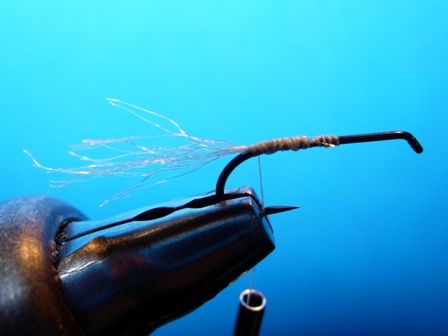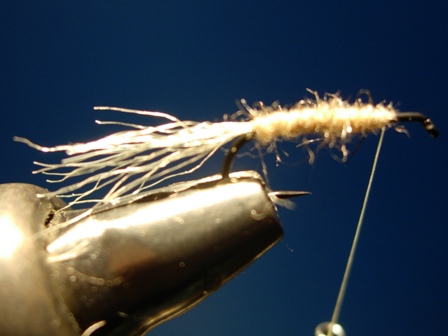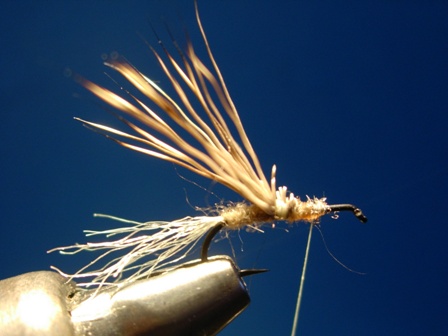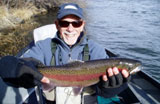Description
 For
those of us who enjoy stillwater fishing,
Callibaetis mayflies are extremely
important. These little critters hatch
throughout the seasons, and are readily
available to hungry trout. They have a
typical mayfly lifecycle: egg, larva
(nymph), and adult. As is the case with all
mayflies, the adult stage consists of two
phases, with the first being the dun (aka
“sub-imago”), with its opaque speckled wings
and brownish body. The second and final
phase is the spinner (aka “imago”), a
transparent wraith-like form whose sole
purpose is to mate, deposit eggs on the
water (in the case of the female), and then
die. For
those of us who enjoy stillwater fishing,
Callibaetis mayflies are extremely
important. These little critters hatch
throughout the seasons, and are readily
available to hungry trout. They have a
typical mayfly lifecycle: egg, larva
(nymph), and adult. As is the case with all
mayflies, the adult stage consists of two
phases, with the first being the dun (aka
“sub-imago”), with its opaque speckled wings
and brownish body. The second and final
phase is the spinner (aka “imago”), a
transparent wraith-like form whose sole
purpose is to mate, deposit eggs on the
water (in the case of the female), and then
die.
The nymph is a good swimmer, using short,
quick bursts of speed to propel itself
around. When the nymph is ready to hatch, a
gaseous bubble forms beneath the wing case
causing the nymph to rise toward the
surface. Once this begins to occur, the
nymph will tend to resist the inevitable,
and will swim back down to the vegetation on
the bottom. This foolish act results in the
demise of many a nymph, as gluttonous trout
gobble them down. This, of course, presents
an opportunity to anglers aware of this
behavior to vary the retrieve when fishing
with nymph imitations. Those nymphs that do
reach the surface must then emerge from
their nymphal shell. We call this brief
phase the “emerger.” Opportunistic trout
pluck hapless emergers from the surface
film—once again giving knowledgeable anglers
an opportunity to fool hungry trout by using
emerger imitations.
Some of the emergers never quite make it out
of the shuck and die trying. These we call
“cripples” or “stillborns.” The lesson here
is simple: even though fully formed duns may
adorn the surface, trout will go for the
easy take and ignore them in favor of the
hapless emergers. Accordingly, I tend to
stick with emergers until it becomes clear
to me that the fish have switched to the
duns. The spinners, upon completion of their
mating and egg-laying activity, will fall to
the water to die. For a short time their
wings will remain upright; as death
approaches, their wings drop prostrate to
the surface. Trout will sometimes feed on
spent spinners, especially when there is a
lull between the spinner fall and the next
hatch. So, it pays to have imitations that
imitate all of the life stages of the
Callibaetis: nymph, emerger, and adult
(including the dun and the spinner phases).
This fly is named after a lake in Washington
where, apparently, fly anglers concentrate
on Callibaetis hatches.
Tying Instructions
(For best viewing: (1) Maximize
your Browser Window. (2) Type "Ctrl
+ or -" to enlarge or contract the
webpage display. (3) Use the
Horizontal and Vertical Scroll Bars
to scroll right and up/down to
display larger photos in your
browser)
|
|
1. Cover rear half of shank with thread. Tie
in a sparse clump of antron or sparkle yarn
just above the back of the barb (or where
that would otherwise be in the case of a
barbless hook). The length should be
approximately the length of the shank of the
hook. |

|
|
|
|
|
2. Dub a sparse abdomen of the antron or
sparkle yarn. Use just enough dubbing to
make the thread “fuzzy.”
|
 |
|
|
|
|
3. At the halfway point on the hook, tie in
a small clump of deer hair with the tips
pointing to the rear.
Trim the butts closely, add a drop of
superglue to the tie-in point, and cover the
butts with thread. This will become the wing
case. |
 |
|
|
|
|
4. Dub in front of the deer hair to form
a thorax. The thorax should be a bit
heftier than the abdomen.
|
 |
|
|
|
|
5. Moisten the tips of the hair (it
makes them easier to handle) and pull
them up and over the thorax, making sure
that the hair stays directly on top of
the hook. Tie the tips down in front of
the thorax, leaving sufficient room
behind the eye to form a nice thread
head.
6. Whip finish behind the eye and in front
of the wing. This will make the tips of the
hair stick out over the eye, while remaining
in a semi-upright position. Apply a small
drop of super glue to the thread wraps,
making sure to keep the hook eye clear of
hair and glue.
|
 |
|
|
|
|
Tying
Tips
1. If you do get glue in the hook eye, take
a small feather and run it through the eye;
this will absorb the errant glue and keep
the eye clean.
2. When fishing this
pattern, apply floatant to the entire fly—not just the body and wing. The reason
for doing this is to keep the fly lying horizontal in the surface film. Other
emerger patterns require avoiding use of floatant on the tail, to allow it to
hang down beneath the surface (e.g., the Klinkhammer Special)—but not this
Callibaetis emerger.
3. When fishing the fly,
use a floating or intermediate line with a long leader tapered to a fine tippet.
Allow the fly to sink, and then begin a short, jerky retrieve; this represents
the swimming nymph. If you suspect that the nymphs are in that “resistance” mode
mentioned above, then give the line a few strips and pause for a few seconds to
let the fly sink back down. |
|
|
|
|
 |
|

